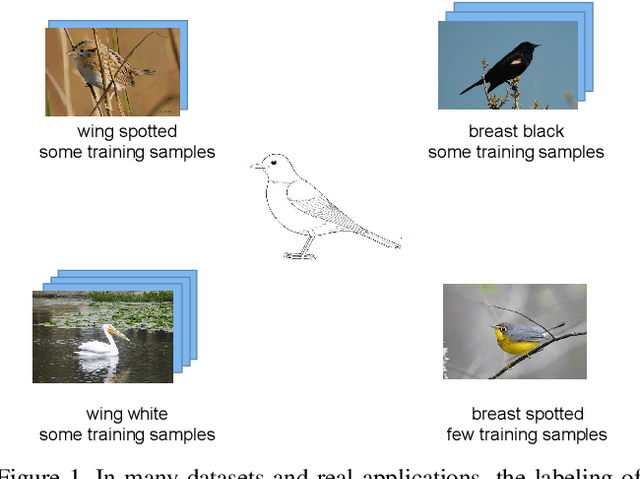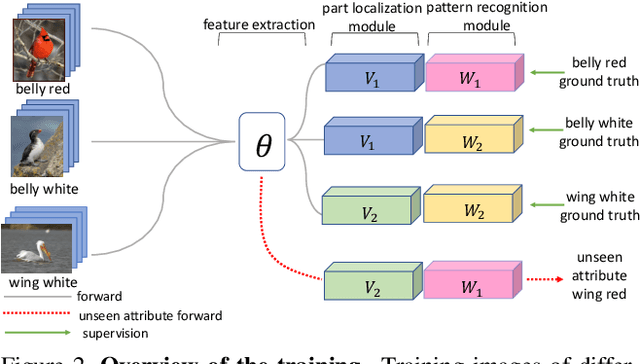Yingze Bao
Action Segmentation with Mixed Temporal Domain Adaptation
Apr 16, 2021



Abstract:The main progress for action segmentation comes from densely-annotated data for fully-supervised learning. Since manual annotation for frame-level actions is time-consuming and challenging, we propose to exploit auxiliary unlabeled videos, which are much easier to obtain, by shaping this problem as a domain adaptation (DA) problem. Although various DA techniques have been proposed in recent years, most of them have been developed only for the spatial direction. Therefore, we propose Mixed Temporal Domain Adaptation (MTDA) to jointly align frame- and video-level embedded feature spaces across domains, and further integrate with the domain attention mechanism to focus on aligning the frame-level features with higher domain discrepancy, leading to more effective domain adaptation. Finally, we evaluate our proposed methods on three challenging datasets (GTEA, 50Salads, and Breakfast), and validate that MTDA outperforms the current state-of-the-art methods on all three datasets by large margins (e.g. 6.4% gain on F1@50 and 6.8% gain on the edit score for GTEA).
Action Segmentation with Joint Self-Supervised Temporal Domain Adaptation
Mar 18, 2020



Abstract:Despite the recent progress of fully-supervised action segmentation techniques, the performance is still not fully satisfactory. One main challenge is the problem of spatiotemporal variations (e.g. different people may perform the same activity in various ways). Therefore, we exploit unlabeled videos to address this problem by reformulating the action segmentation task as a cross-domain problem with domain discrepancy caused by spatio-temporal variations. To reduce the discrepancy, we propose Self-Supervised Temporal Domain Adaptation (SSTDA), which contains two self-supervised auxiliary tasks (binary and sequential domain prediction) to jointly align cross-domain feature spaces embedded with local and global temporal dynamics, achieving better performance than other Domain Adaptation (DA) approaches. On three challenging benchmark datasets (GTEA, 50Salads, and Breakfast), SSTDA outperforms the current state-of-the-art method by large margins (e.g. for the F1@25 score, from 59.6% to 69.1% on Breakfast, from 73.4% to 81.5% on 50Salads, and from 83.6% to 89.1% on GTEA), and requires only 65% of the labeled training data for comparable performance, demonstrating the usefulness of adapting to unlabeled target videos across variations. The source code is available at https://github.com/cmhungsteve/SSTDA.
Cross-Modality Attention with Semantic Graph Embedding for Multi-Label Classification
Dec 17, 2019



Abstract:Multi-label image and video classification are fundamental yet challenging tasks in computer vision. The main challenges lie in capturing spatial or temporal dependencies between labels and discovering the locations of discriminative features for each class. In order to overcome these challenges, we propose to use cross-modality attention with semantic graph embedding for multi label classification. Based on the constructed label graph, we propose an adjacency-based similarity graph embedding method to learn semantic label embeddings, which explicitly exploit label relationships. Then our novel cross-modality attention maps are generated with the guidance of learned label embeddings. Experiments on two multi-label image classification datasets (MS-COCO and NUS-WIDE) show our method outperforms other existing state-of-the-arts. In addition, we validate our method on a large multi-label video classification dataset (YouTube-8M Segments) and the evaluation results demonstrate the generalization capability of our method.
Recognizing Part Attributes with Insufficient Data
Aug 13, 2019



Abstract:Recognizing attributes of objects and their parts is important to many computer vision applications. Although great progress has been made to apply object-level recognition, recognizing the attributes of parts remains less applicable since the training data for part attributes recognition is usually scarce especially for internet-scale applications. Furthermore, most existing part attribute recognition methods rely on the part annotation which is more expensive to obtain. To solve the data insufficiency problem and get rid of dependence on the part annotation, we introduce a novel Concept Sharing Network (CSN) for part attribute recognition. A great advantage of CSN is its capability of recognizing the part attribute (a combination of part location and appearance pattern) that has insufficient or zero training data, by learning the part location and appearance pattern respectively from the training data that usually mix them in a single label. Extensive experiments on CUB-200-2011 [51], CelebA [35] and a newly proposed human attribute dataset demonstrate the effectiveness of CSN and its advantages over other methods, especially for the attributes with few training samples. Further experiments show that CSN can also perform zero-shot part attribute recognition. The code will be made available at https://github.com/Zhaoxiangyun/Concept-Sharing-Network.
 Add to Chrome
Add to Chrome Add to Firefox
Add to Firefox Add to Edge
Add to Edge